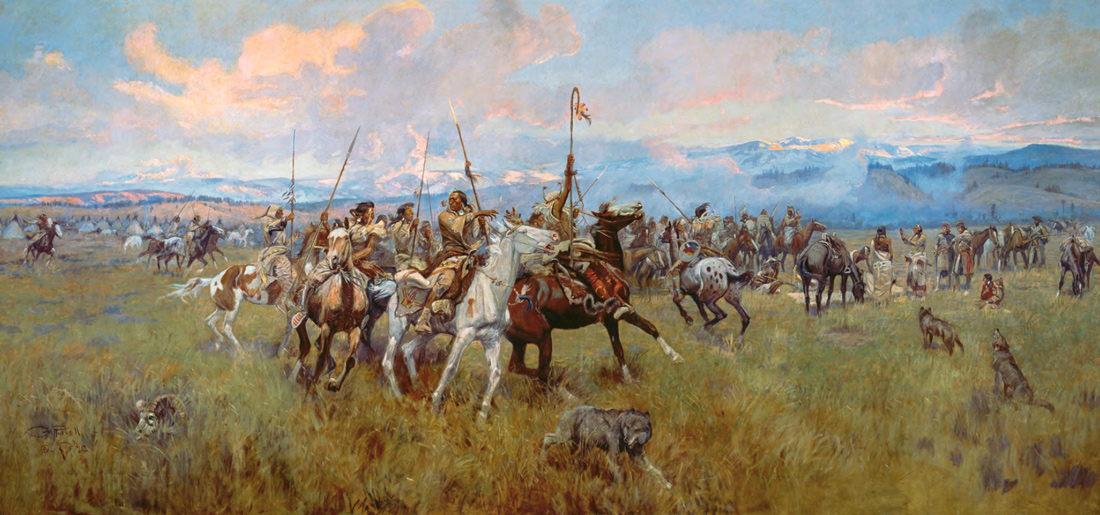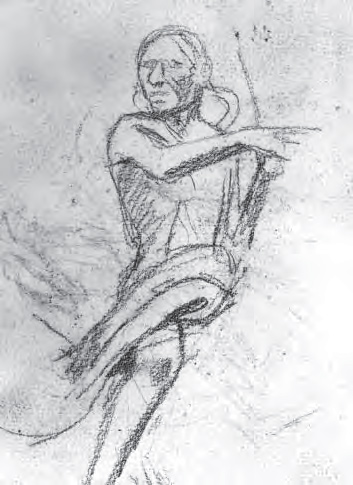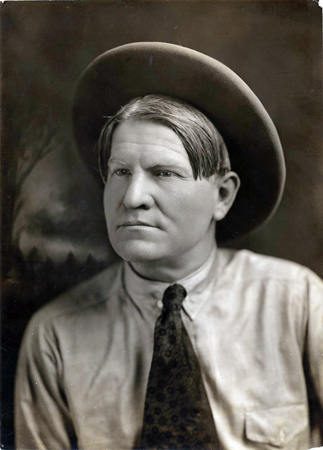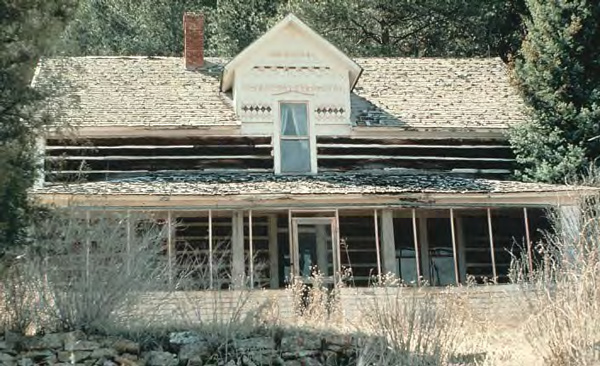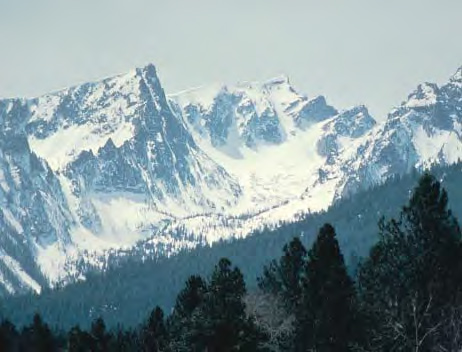A character in a story by Norman Maclean describes the Bitterroot Mountains in western Montana as a “wall . . . which could have been the end of the world . . . windrows of momentary white. Beyond the wall, it seemed likely, eternity went on in windrows of Bitteroot Mountains and summer snow.”[2]Norman Maclean, “U.S. Forest Service 1919: The Ranger, the Cook, and a Hole in the Sky,” A River Runs Through It and Other Stories (Chicago: University of Chicago Press, 1976), p. 146.
Lewis and Clark Meeting Indians at Ross’ Hole
by Charles M. Russell (1864–1926)
Reproduced by permission of the Montana Historical Society.
Although Russell’s commission sought to glorify the Anglo-American conquest, the artist chose to place the Indians at the center of his narrative and relegated Lewis and Clark to the background. The expedition’s Lemhi Shoshone guide, nicknamed Toby, speaks Plains Sign Language with the Salish while Lewis and Clark look on. York holds the horses, and Sacagawea kneels in the grass.
Similar feelings may have engulfed Lewis and Clark when the Corps of Discovery faced the Bitterroots in early September 1805, after they came to the reluctant conclusion that only an overland route through the mountains, and not a river route, could take them to their westward destination. For this, they would need more horses than they had ever imagined, more information than they had any hope of acquiring, and more courage than they thought they had brought with them. It was a daunting moment. Then occurred a blessed encounter. After leaving their Shoshone friends, Sacagawea’s people, they climbed with great difficulty a spur of the Bitterroots and then descended through Lost Trail Pass, eventually entering a beautiful valley which we today call Ross’ Hole.[3]Possible routes and campsite are discussed in Gary E. Moulton, ed. The Journals of the Lewis and Clark Expedition, (Lincoln: University of Nebraska Press, 1988), Vol. 5, pp. 186–88. The Corps of … Continue reading There, on 4 September 1805, they surprised “a large camp of Indians . . . called Ootlashoots. . . . one band of a nation called Tush-epaws.”[4]Elliott Coues, ed., The History of the Lewis and Clark Expedition by Meriwether Lewis and William Clark (New York: Dover Publications, Inc., 1965; reprint of 1893 edition), Vol. 2, pp. 581–83. The Salish, or Flatheads as they came to be known, were on their way eastward to kill buffalo before winter came. The explorers visited with them, purchased horses, and obtained directions. Perhaps they even replenished their courage. Whatever they got sufficed for their journey across the mountains. This was their last contact with an Indian community before the completion of the arduous crossing of the main range which spilled them into the land of the Nez Perce in present-day Idaho. Not a moment of high drama in the Lewis and Clark saga, perhaps, but certainly one of strategic importance. It also had the kind of pictorial potential—the forbidding mountains, the friendly Indians, the rituals governing the meeting—that a good visual narrative called for.
This is the incident immortalized by artist Charles M. Russell in the painting commissioned by the Montana state government for the legislative chamber of the Capitol, in Helena, in 1911, Lewis and Clark Meeting Indians at Ross’ Hole.[5]This is the official title of the work as listed at the Montana Historical Society. The painting has been known by many different titles over its lifetime, but the preferred one is that chosen by the … Continue reading It was not, however, his first subject choice, or for that matter, his choice at all. With how little reflection one can only wonder, Russell had originally suggested an attack by Indians on a wagon train or Lewis’s meeting with the Shoshones. On 11 November 1911, Governor Edwin L. Norris acknowledged receipt from Russell of two watercolor sketches on these subjects, neither one of which the Board of Examiners found acceptable. The Governor replied starchly that the Indian attack “does not appeal to us as a suitable decoration for the House of Representatives.”[6]Montana Historical Society, Montana Board of Examiners Records, Collection No. RS196, Box 2, Folder 37. All correspondence citations are from this source unless otherwise noted. The preliminary … Continue reading The second possibility showed an encounter that had taken place in Idaho, not Montana, the Governor patiently explained. Norris claimed to have immersed himself in the Journals of Lewis and Clark, where he found two episodes that would be suitable—the meeting with the Flatheads or the fight between Lewis’s party and Blackfeet Indians on the Upper Marias River during the return trip. Russell, the Governor, and the Board of Examiners eventually agreed that the meeting with the Flatheads would work best.
Correspondence between government officials and Russell and the other two artists selected for this phase of decoration of the Capitol was often similarly contentious in tone. The decoration of the original Capitol, during the administration of Joseph K. Toole, was undertaken by Charles A. Pedretti for F. Pedretti’s Sons, a professional firm in Cincinnati primarily devoted to architectural decoration. Relations apparently proceeded relatively smoothly. The later effort, what might be called the Populist phase of Capitol decoration, was given over to three Montana artists—Russell, Edgar Samuel Paxson (1852–1919) and Ralph DeCamp (1858–1936)—by government fiat. Senate joint Resolution No. 4, approved on February 2, 1911, stipulated that the imagery be based on “early Montana scenes and figures, as are of value from a historical standpoint, and that such decorations be executed by Montana Artists of recognized ability and standing.” Paxson was asked to do several paintings of mixed sizes for the vestibule of the House principally on the Lewis and Clark theme, and DeCamp, a series of landscapes for the former Law Library. It is evident from their many communications that the Montana artists did not enjoy the full confidence of the Governor and his committee. The fact that Russell and Paxson bungled their subjects at the outset and got the sizes of their respective paintings wrong (which brought down on their heads the wrath of Attorney General Albert J. Galen) did not help.[7]In the case of Russell, at least, the government eventually acknowledged some culpability in the misunderstanding. Russell’s contract contained a serious misstatement of size—about 12 by 14 … Continue reading
Worst of all, the Board of Examiners feared that Russell would fail to finish his painting on time. Governor Norris visited Great Falls in early April 1912 and was appalled to learn that Russell had made little progress on the commission. The ensuing controversy was played out in the daily press at stage-voice decibels. A headline in the Great Falls Daily Tribune for Monday, April 8, blared, WANTS RUSSELL TO START ON HIS WORK. The text stated that Norris was insisting on a firm deadline of September 1 and unfavorably compared Russell’s delay to the industry and promptness of the other two artists. The next day’s edition of the Tribune carried an angry response headlined, RUSSELL’S WORK WILL BE DONE ON TIME, SAY FRIENDS. On April 30, Norris sent an official complaint to Russell at his studio, in Great Falls, which occasioned an indignant reply from his wife and business manager, Nancy. On May 2, she wrote that the artist “is devoting his entire time to the mural and it is progressing rapidly, beyond our expectations.” The fears of Norris and the committee were not entirely unfounded. Russell had made extensive forays away from home that spring, first to New York and later to Florida, when he might reasonably have been expected to be at work on the Capitol commission. Nancy Russell’s determined rejoinder, however, pointed out a salient aspect of the artist’s working methods—his astonishing rapidity. The painting was installed in the House of Representatives ahead of schedule on July 11, 1912.
Critique
Many reservations Norris and his committee may have had were buried in an avalanche of praise. An anonymous reviewer writing in the Great Falls Daily Tribune in a tone of lofty intellectual authority lauded the painting unstintingly. “If all the works of Russell, save this, were to perish,” he enthused, “this picture would stand alone as a monument to his genius which would give him a leading place among America’s great artists.” Interestingly, the reviewer did not structure his remarks in terms of the painting’s formal properties of technique, facture, or style, but instead emphasized “the subject and its development,” thus drawing attention to Russell’s narrative gifts.
Certain it is that Russell’s first attempt at history painting on a monumental scale for a public place was a decided triumph, made so especially by his narrativizing strategies. The sweep of horses and Indian riders into the center foreground, the tilted lances, the dramatic cloud patterns, create an action scene of stupendous energy and vitality. The historically significant negotiations between Lewis and Clark and the tribal leaders, on the other hand, are almost lost to view in the quiet of the middle ground at right. Russell’s decision to privilege the Indians was not just an exercise in picturesqueness but a conscious narrativization of an alternative history. What he understood to be the heroic life of the Indians, whose land this was, would be forever and entirely changed by the visit from the unprepossessing characters. He lavished dramatic treatment on the people who would soon be vanquished, knowing full well the unfathomable power that lay behind the gentle intruders.
There has been considerable commentary about the mountain background that forms the upper horizontal plane of the painting, starting with the obvious fact that spring scenery is depicted in an incident that took place in early September. It is also noticeable that the higher elevations at the right do not appear to segue properly with the southern part of the range to the left, which may be one of the reasons why Russell allowed the clouds and mist to obscure the elisions as much as they do. Russell made on-site sketches for the mountainscape which unfortunately seem not to have survived, or at least not to have been so identified. In a letter dated 21 May 1912, Nancy Russell reassured Governor Norris that “the picture is progressing beautifully,” adding that Russell “goes to Ross’s Hole this week for the mountain background.” Local newspapers picked up this information, as they did practically every detail of Russell’s life, with estimates of the time spent in the Sula basin ranging wildly from two days to two months.
Tradition holds that Russell made the sketches on the front porch of the log cabin owned by Jake and May Wetzsteon on a western hill overlooking the Sula basin, in the valley of the East Fork of the Bitterroot River, east of the town of Sula.[8]See notations by Mrs. Jake Wetzsteon (1944) and Peggy Wetzsteon Windsor (1979) in Bitterroot Trails, ed. Lena Eversole Bell and Henry Hamilton Grant (The Bitter Root Valley Historical Society, 1982), … Continue reading This could only be partly correct, because the front porch looks southeast to the foothills rather than west and north to the main range of the Bitterroots. Reminiscing many years later, however, Nancy Russell recalled that “We stayed at Darby [a town some 25 miles downstream (north), on the main stem of the Bitterroot] and hired a buckboard to take us around through that part of the country so that Charlie could get the lay of the land.”[9]Letter from Nancy Russell to R. H. Fletcher, November 14, 1936, in the Homer E. Britzman Collection, Taylor Museum for Southwestern Studies, Colorado Springs Fine Arts Center.
Trapper Peaks, which appears in the left background of the painting. The Bitterroots proved a formidable barrier to the Corps of Discovery.
There is indeed a section of road along present-day Route 93 a few miles north of Sula that offers a view somewhat similar to the one in the painting—the motif of high mountains presiding majestically over forested foothills—but the contours do not match exactly. The characteristic cragginess of the Bitterroots is missing from the painting. An early 20th-century photograph of the area by Montana photographer Bertie Lord, although less panoramic in its extent, reveals the same kind of juxtaposition of higher and lower mountains emphasized by Russell. The outlines of The Trapper Peaks, caught so well by Lord, are distinctly visible in the left portion of Russell’s mural. As for the rest of the mountainscape, it appears to be a more generalized image of Bitterroot scenery. Russell was usually attentive to the specifics of site when the subject demanded it; if he painted what he called a Glacier Park scene, then certainly it resembled Glacier Park scenery. It is somewhat surprising that greater fidelity to the site is not more apparent in the Capitol mural, especially considering the fact that he made a documented visit to the area in order to make visual observations. But perhaps the fault lies with the critics—we simply have not yet found the match between site and scene. Russell did not compromise the larger truth he envisioned, however. The vast expanse of high mountain area, even if not topographically exact, convincingly characterizes the “wall” of “windrows of momentary white” that stood between the Corps of Discovery and the realization of its goal.
Likewise, one could criticize some of the details of costume, etc., of the Indians, as many anthropologists and others have. What can be credited to Russell, however, is that, within the limitations of historical knowledge available to him at the time, his record for accuracy is actually quite good. He had recourse to historical materials in the Great Falls library, he of course had read the Journals of Lewis and Clark (although they would not necessarily have provided complete visual descriptions), and he had amassed his own collection of Indian artifacts on which he drew regularly.[10]Russell probably would have used the 1893 version edited by Elliott Coues already cited, or possibly Reuben Gold Thwaites, ed., Original Journals of the Lewis and Clark Expedition, 1804–1806, (New … Continue reading One mystery remains: why he clothed the black slave York (visible in the painting tending the horses to the right of Lewis and Clark) in tight breeches and a tri-corner hat rather than more rustic wear. He dressed the figure in breeches again in the watercolor York, the often-reproduced painting depicting him stripped to the waist in a Mandan earth lodge. Yet an undated costume study of York by Russell shows him in buckskins, indicating an alternative conception. For the Capitol mural, Russell seemingly made a conscious decision (no doubt based on what he thought were authoritative visual or verbal sources) to render York in what otherwise might seem to be an idiosyncratic choice of costume.[11]The definitive study of York is by Robert B. Betts, In Search of York (Boulder: Colorado Associated University Press, 1985). Although Betts does not discuss visual representations of York’s … Continue reading
Visual Storytelling
An artistic task of at least as great importance to a history painter as getting his facts straight was the ancient one of “invention.” That is, the creation of composition, poses, and gestures in order to signify the meaning of the action—what Russell’s reviewer in 1912 had referred to as “the subject and its development.” In 1771, the British artist Sir Joshua Reynolds stated: “Whenever a story is related, every man forms a picture in his mind of the action and expression of the persons employed. The power of representing this mental picture on canvas is what we call invention in a painter.”[12]Sir Joshua Reynolds, Discourses on Art, Stephen O. Mitchell, ed. (New York: The Bobbs-Merrill Co., 1965), p. 40. In all likelihood, Charlie Russell had never heard of Sir Joshua Reynolds, and in any case, his artistic aims differed radically from those of Reynolds. But he was nevertheless intuitively aware of the importance of “invention” to visual storytelling. In the attention he gave to compositional values as well as to individual expression, we can see the “power” of the original mental picture transferred to canvas. Note how, at the precise center of the canvas, the principal Indian figure looks to the right while extending his right arm laterally in the opposite direction in a bold, Michelangelesque gesture. Russell made numerous pencil sketches of this figure until he arrived at the pose, the physical features, and above all, the telling gesture that would heighten the drama of this encounter. The expression on the face is severe, even fierce; the action is quick, vigorous, commanding. Lewis and Clark, on the other hand, are characterized as patient, thoughtful, and above all cautious as they await the results of the Shoshone guide’s translation efforts. Although Russell worked hard on the particulars of individual expression, it is the great sweep of action that gives the picture its epic breadth. The arc of riders that stops its full gallop only at the very last minute, as if within a few feet of the viewer, is one of Russell’s most dynamic compositions. Russell not only understood well the demands of narrative for psychology of expression, but also the need to enhance the meaning of the incident by creating a significant action. Governor Norris and his committee needn’t have worried so about the three Montana artists. Paxson’s figures, perhaps the weakest of the three, are too big for the limited sight lines of the vestibule in which they hang, and are rather wooden, but the ensemble is nicely colored and “decorative” in the Pedretti sense. DeCamp’s landscapes, surprisingly small in scale, are beautifully painted and confer a lyrical presence on the former Law Library. But it is Russell’s Lewis and Clark Meeting Indians at Ross’ Hole that dominates its space, not only physically, but psychologically, and perhaps one might say, even morally. Russell’s ultimate achievement was to tender a highly personal and critical interpretation of a significant event in national history that took place on the soil of his adopted state, one with extremely serious consequences for two nations. Against the grain of the rest of the Capitol imagery, which sought to valorize the Anglo-American conquest, Russell alone made a significant counter-statement. This is not to try to further the impression of Russell as a simple-minded sentimentalist bent on showing the superiority of the Indian. Revisionist historians have sought to change that conception of Russell, showing that Russell’s mindset on these matters was highly complex.[13]For two quite different but serious and responsible analyses of this problem, see Raphael Cristy, “Charlie’s Hidden Agenda: Realism and Nostalgia in C. M. Russell’s Stories about … Continue reading In this one painting, however, so strategically placed, he tweaks the noses, pricks the consciences, and moves the hearts of the legislative body. One of the principal tenets of traditional history painting held that the artist’s most necessary and noble function was to instruct the viewer. In Lewis and Clark Meeting Indians at Ross’ Hole, Russell did just that. He seemed to know instinctively that it should be done, what the lesson should be, and how to go about doing it.[14]Funding for the research for this article was obtained from two grants from the National Endowment for the Humanities, a Travel to Collections grant in 1992 and a Summer Stipend in 1994, for both of … Continue reading
See also Meeting the Salish.
Notes
| ↑1 | This article originally appeared in: Patricia M. Burnham, “Lewis and Clark at Ross’ Hole: The Story Behind Charles M. Russell’s 1912 painting . . .”, We Proceeded On, August 2000, Volume 26, No. 3. The original article is provided at https://lewisandclark.org/wpo/pdf/vol26no3.pdf#page=19. The WPO article first appeared in somewhat different form in Russell’s West, Vol. 3, No. 1 (1995), the publication of the C. M. Russell Museum, in Great Falls, Montana (www.cmrussell.org). |
|---|---|
| ↑2 | Norman Maclean, “U.S. Forest Service 1919: The Ranger, the Cook, and a Hole in the Sky,” A River Runs Through It and Other Stories (Chicago: University of Chicago Press, 1976), p. 146. |
| ↑3 | Possible routes and campsite are discussed in Gary E. Moulton, ed. The Journals of the Lewis and Clark Expedition, (Lincoln: University of Nebraska Press, 1988), Vol. 5, pp. 186–88. The Corps of Discovery probably camped with the Salish on the east side of Camp Creek, near its junction with the East Fork of the Bitterroot. |
| ↑4 | Elliott Coues, ed., The History of the Lewis and Clark Expedition by Meriwether Lewis and William Clark (New York: Dover Publications, Inc., 1965; reprint of 1893 edition), Vol. 2, pp. 581–83. |
| ↑5 | This is the official title of the work as listed at the Montana Historical Society. The painting has been known by many different titles over its lifetime, but the preferred one is that chosen by the Historical Society, which is the same title as that listed in A Bibliography of the Published Works of Charles M. Russell, compiled by Karl Yost and Frederic G. Renner (Lincoln: University of Nebraska Press, 1971), p. 293. Russell himself used this title in his copyright application. See Yost and Renner, p. v. |
| ↑6 | Montana Historical Society, Montana Board of Examiners Records, Collection No. RS196, Box 2, Folder 37. All correspondence citations are from this source unless otherwise noted. The preliminary sketches have never been found. |
| ↑7 | In the case of Russell, at least, the government eventually acknowledged some culpability in the misunderstanding. Russell’s contract contained a serious misstatement of size—about 12 by 14 feet instead of 12 by 25 feet—which the Board of Examiners felt should have been recognized immediately as an error. Nevertheless, on 29 January 1912, Attorney General Galen promised to reimburse Russell for the canvas he had purchased in the wrong size that was now unusable. Montana State Archives—Attorney General. A remnant of the canvas remains in the collection of the C. M. Russell Museum. |
| ↑8 | See notations by Mrs. Jake Wetzsteon (1944) and Peggy Wetzsteon Windsor (1979) in Bitterroot Trails, ed. Lena Eversole Bell and Henry Hamilton Grant (The Bitter Root Valley Historical Society, 1982), pp. 65 and 77. The Wetzsteon’s log cabin was torn down in the early 1990s. |
| ↑9 | Letter from Nancy Russell to R. H. Fletcher, November 14, 1936, in the Homer E. Britzman Collection, Taylor Museum for Southwestern Studies, Colorado Springs Fine Arts Center. |
| ↑10 | Russell probably would have used the 1893 version edited by Elliott Coues already cited, or possibly Reuben Gold Thwaites, ed., Original Journals of the Lewis and Clark Expedition, 1804–1806, (New York: Dodd, Mead & Co., 1904–05). In her letter to R. H. Fletcher previously cited, Nancy Russell stated that the Lewis and Clark journals he consulted had “disappeared in some way.” |
| ↑11 | The definitive study of York is by Robert B. Betts, In Search of York (Boulder: Colorado Associated University Press, 1985). Although Betts does not discuss visual representations of York’s dress in art, he does mention that house slaves, particularly the body servant, often wore the castoff garments of the master (p. 95). |
| ↑12 | Sir Joshua Reynolds, Discourses on Art, Stephen O. Mitchell, ed. (New York: The Bobbs-Merrill Co., 1965), p. 40. |
| ↑13 | For two quite different but serious and responsible analyses of this problem, see Raphael Cristy, “Charlie’s Hidden Agenda: Realism and Nostalgia in C. M. Russell’s Stories about Indians,” Montana: The Magazine of Western History, Summer 1993 (Vol. 43, No. 3), pp. 2–15; and Alexander Nemerov, “Projecting the Future: Film and Race in the Art of Charles Russell,” American Art, Winter 1994 (Vol. 8, No. 1), pp. 71–89. |
| ↑14 | Funding for the research for this article was obtained from two grants from the National Endowment for the Humanities, a Travel to Collections grant in 1992 and a Summer Stipend in 1994, for both of which I am extremely grateful. I also extend my deepest appreciation to the staff of the Montana Historical Society, Rick Stewart at the Amon Carter Museum, and Ginger Renner. |
